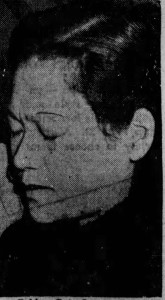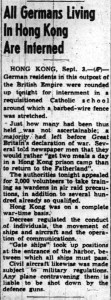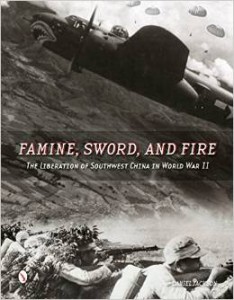Posted: October 8th, 2015 | No Comments »
What possessed Mrs Seto Gin of Shanghai to become a drug mule in 1939? War, impoverishment, opportunity, blackmail, the chance to turn a quick buck and exit Japanese occupied Shanghai? We don’t know…but she did. In early January 1939 she was busted by U.S. Customs Agents as she stepped off the American President Lines ship the President Coolidge from Hong Kong….
In the middle to late 1930s criminal gangs in China, Hong Kong and Macao (Chinese and foreign) smuggled vast amounts of opium into America. Some went in large batches but most went in luggage – rotating Fourth Marines, showgirls heading back to America and Chinese making the crossing. Wealthy middle class Shanghainese were particularly popular with the gangs as they were not examined as closely as poorer Chinese arriving. But clearly being too glamorous also attracted the attentions of the customs men…
Here, from 1939, 32-year-old Mrs Seto Gin attracted some attention. She was busted, wearing a “lustrous Chinese gown”, “brocaded” and “slit to above the knee”, disembarking at San Francisco. She is described as “young” and “attractive” in one newspaper and “petite” and “Almond-eyed” in another. She is carrying a not inconsiderable 49 cans of opium (it was often repacked into cans claiming to contain Chinese confectionery) in, wait for it, a trunk with a false bottom – not an overly original stash spot, even in 1939. The stash was worth US$10,000 (another newspaper said US$100,000 – but that sounds a bit high for 49 5-tael cans in 1939 – valued at US$65 a tin – and I’ve seen the 10Gs reference elsewhere).
Customs quickly searched other arriving passengers but found that a Mr Chung Lei, a former Chinese bank president according to the ship’s passenger records (presumably fallen on hard times since the Japanese invasion) had already gone ashore and disappeared. As the only other passenger to have boarded in Hong Kong with Seto Gin the police announced that they would like to speak with him.
Tomorrow – The Trial…
 Seto Gin…busted
Seto Gin…busted
Posted: October 7th, 2015 | No Comments »
An online archive definitely worthy of a plug – a database of the Heidelberg Research Architecture (HRA) on Republican-era Chinese women’s magazines including Nüzi shijie (Women’s World, 1904-07), Funü shibao (The Women’s Eastern Times, 1911-17), Funü zazhi (The Ladies’ Journal, 1915-31), and Linglong (Elegance, 1931-37). Trust me – you’ll spend a good portion of your day searching through these old issues once you start!

Posted: October 7th, 2015 | No Comments »
So it seems Hong Kong’s post boxes are to have their royal cyphers covered up to stop “confusion”! Not sure what the confusion was exactly – I’m pretty sure everyone in Hong Kong knows what a post box looks like and didn’t think they were just boxes to drop letters to the Queen into!! But Hong Kong Post thinks differently – or rather some bureaucrat in Beijing thinks they should think differently. The Hong Kong Conservancy Association is having a go at convincing Hong Kong Post otherwise but orders are orders it seems. More here.
The 59 old post boxes remaining in use in Hong Kong are of different ages, including seven with the royal cyphers GRV for King George V, two GRVI for King George VI, 49 with ERII for Queen Elizabeth II, and just one with a Crown of Scotland in Central, according to the website of HK Post-Box Search Team. After the handover, the previously red post-boxes, brought over from England, were painted green.
Several cities in China used to have some nice Republican era post boxes still in use – such as these in Dalian (that were there in 2009 at least)…but Hong Kong will apparently have to change….





Posted: October 6th, 2015 | 1 Comment »
Meant to post this in September but forgot!! Anyway, September 1939 and all Germans living in Hong Kong were interned – put in a Catholic School and surrounded with barbed-wire. The school was La Salle College on Prince Edward Road in Kowloon run by the Christian Brothers (the current site is a later building – the original, as in 1939, is far grander and shown below). The fact that the internees preferred their two squares a day in internment to being shipped back to Hitler’s Fatherland may be a bit of Brit propaganda but maybe not – sunny Hong Kong was probably preferable to Germany.
Hong Kong went on full war alert – much as the UK with Air Raid Wardens, Fire Marshals, beefing up protections around the harbour against sneak attacks and dealing with the possibility of air attack. The final battle was of course not to come until after Pearl Harbor in December 1941 and was, of course, against the Japanese rather than the Germans….


Posted: October 5th, 2015 | No Comments »
Daniel Jackson’s Famine, Sword and Fire deals with the American troops in Southwest China in WW2 – a group rather conspicuously absent from the recent Beijing 70th anniversary WW2 parade where apparently nobody fought with the Chinese!

The untold story of Chinese and Americans standing side-by-side, fighting together and dying together on the highest, most rugged battlegrounds of WWII. In May 1942, the Japanese 15th Army conquered Burma and southwest China. Only a desperate defense by disorganized and defeated Chinese troops and the war-weary remains of Claire Chennault’s mercenary Flying Tigers stopped the advance at the Salween River. For two years, the people of southwest China lived under an oppressive Japanese occupation while Generalissimo Chiang Kai-shek, President Franklin Roosevelt, General Joseph Stilwell, and Major General Claire Chennault bickered over what to do next. Finally, in May 1944, the Chinese Expeditionary Force, with American supplies and advisors, supported from above by the legendary 14th Air Force, crossed the Salween to take back what they had lost.
Posted: October 4th, 2015 | No Comments »
I just reviewed A Yi’s new China-set thriller A Perfect Crime at the Los Angeles Review of Books…with some references to previous Chinese literary giants…click here

Posted: October 3rd, 2015 | No Comments »
Japan attacked and occupied Peking in July 1937 – this picture from January 1938 is of a Japanese machine gun nest close to the city….

Posted: October 2nd, 2015 | 1 Comment »
Back when I edited Carl Crow’s wartime diaries (The Long Road Back to China) I came across this reference to the “Michelin” that ran from Kuming to Hanoi in those days. Crow describes it, as below from his diaries, but I was never quite sure what it looked like. My thanks to Andrew Hicks, editor of the Jack Jones’s memoir on the Friends Ambulance Unit China Convoy between 1945 and 1951, A True Friend to China, for this photo of the “Michelin”…
“Kunming-Hanoi, Monday, June 19th 1939. Everybody yesterday talked about how lucky I was to get a seat on the “Michelinâ€. It was partly luck but I wouldn’t have gotten the seat unless I had gone to the station personally and had a look myself at the seat plan and discovered those two vacant places. I was up at 5 o’clock and the dejeuner was very petit as it con- sisted only of bread, butter and coffee. They had told me the train would leave at 6:30 but I found out that it was the bus that was to leave at that time. Eigner went with me as he was going to Hanoi by the slow train that left a half hour later.
I didn’t know what the “Michelin†really was until I got aboard. It is a big motor bus that was on the railway tracks – about the size of a Greyhound bus at home, but not so comfortable. one thing that struck me especially was the tinted glass in the windows that not only kept out the glare but actually made the colors of the landscape more vivid. I would have been just as happy with a little glare and a little better upholstery but I wonder why railways at home have not adopted this kind of glass.”













